Human Resource Management: Recruitment Weaknesses and HR Planning
VerifiedAdded on 2023/06/15
|11
|2509
|499
Report
AI Summary
This report critically examines human resource management, focusing on two significant weaknesses in the recruitment and selection process: inadequate job descriptions and unprofessional interviews, detailing their consequences and proposing actionable solutions. It further explores the importance of human resource planning, highlighting its role in future workforce requirements, adapting to change, efficient personnel recruitment, and reducing uncertainty. The report also analyzes the impact of technological advancements on HR, specifically in recruitment and data storage, and predicts future trends like algorithm hiring. It concludes that addressing recruitment weaknesses and leveraging technology in HR planning are crucial for organizational success, while emphasizing the irreplaceable value of the human element in the hiring process. Desklib provides access to similar solved assignments and study tools.
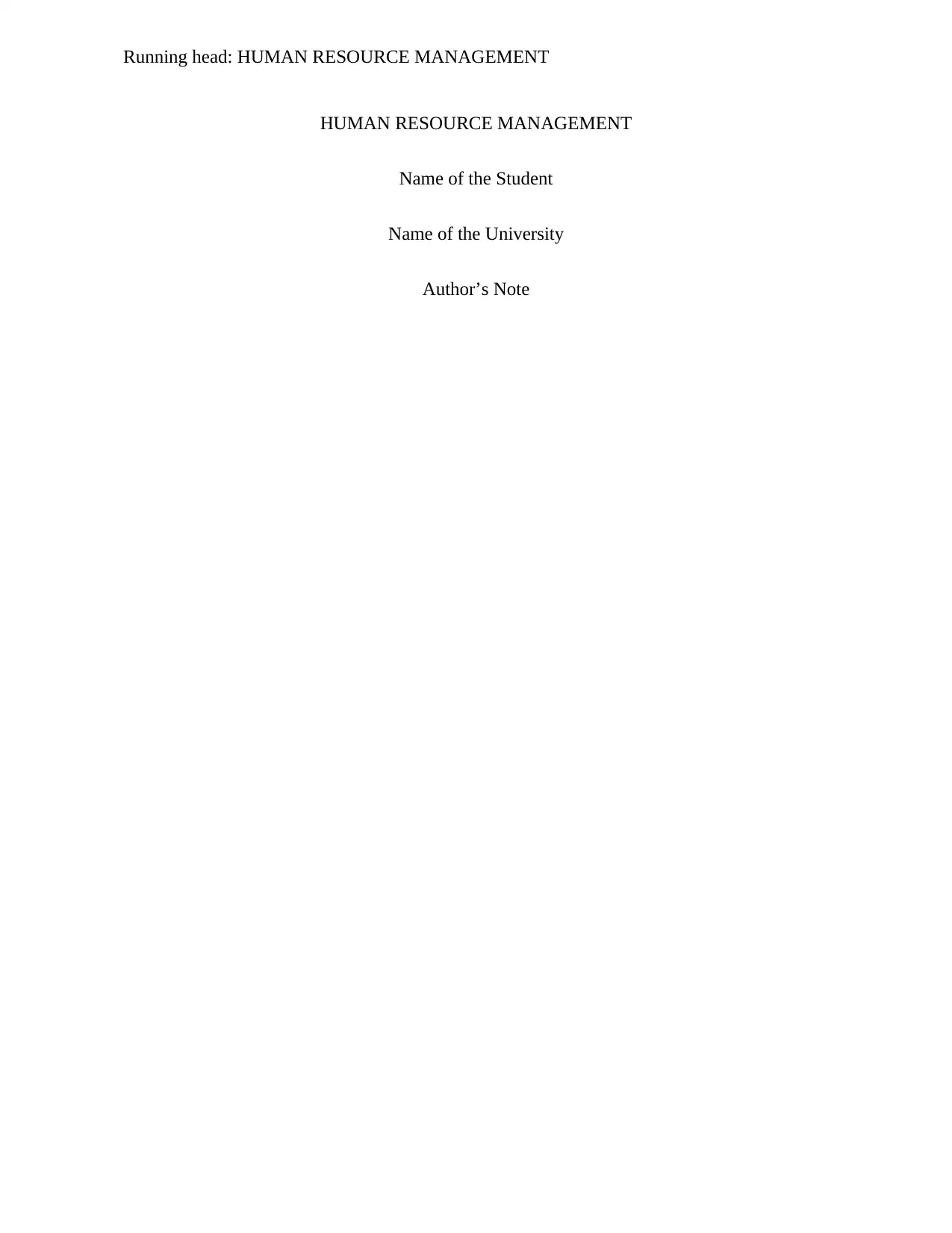
Running head: HUMAN RESOURCE MANAGEMENT
HUMAN RESOURCE MANAGEMENT
Name of the Student
Name of the University
Author’s Note
HUMAN RESOURCE MANAGEMENT
Name of the Student
Name of the University
Author’s Note
Paraphrase This Document
Need a fresh take? Get an instant paraphrase of this document with our AI Paraphraser
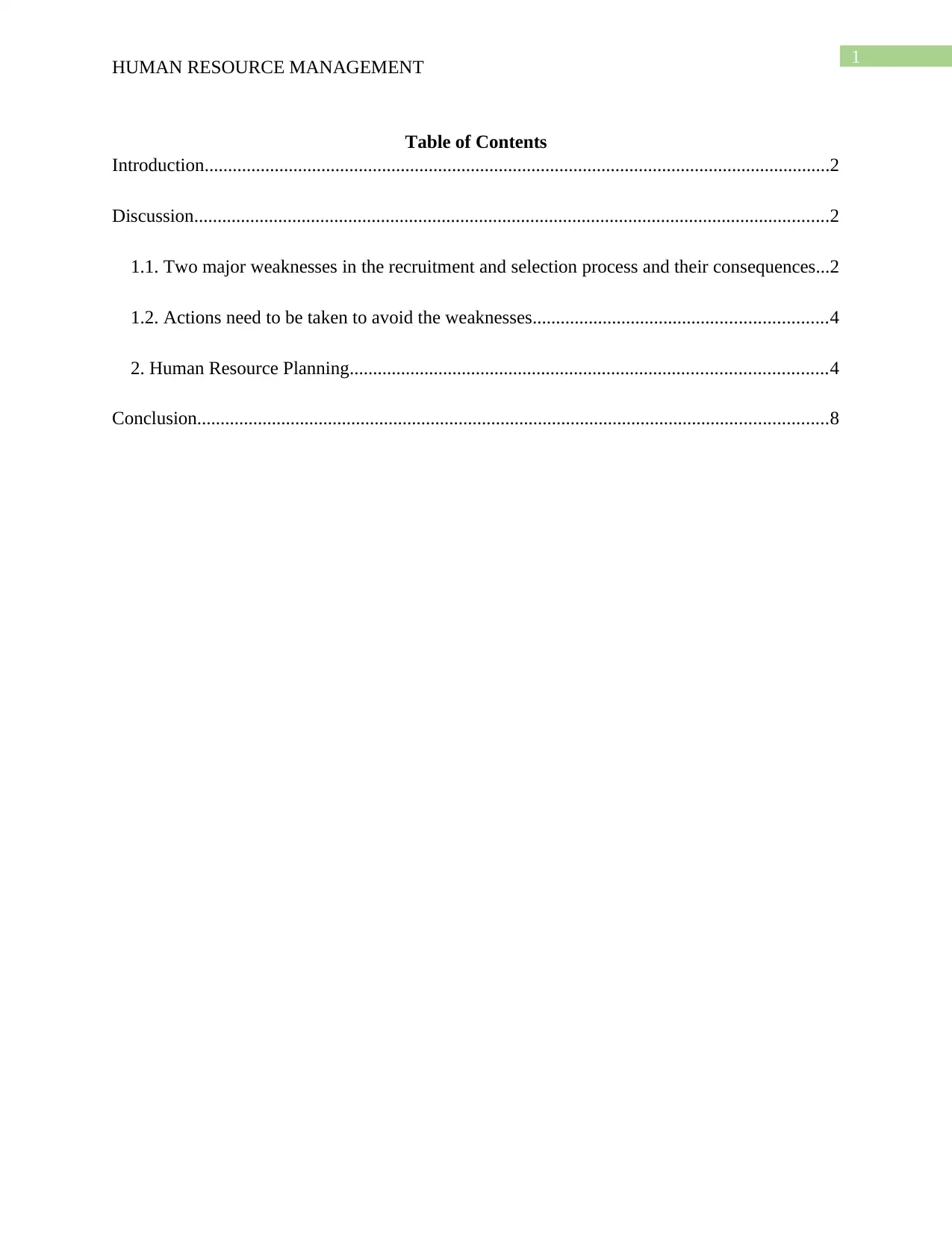
1
HUMAN RESOURCE MANAGEMENT
Table of Contents
Introduction......................................................................................................................................2
Discussion........................................................................................................................................2
1.1. Two major weaknesses in the recruitment and selection process and their consequences...2
1.2. Actions need to be taken to avoid the weaknesses...............................................................4
2. Human Resource Planning......................................................................................................4
Conclusion.......................................................................................................................................8
HUMAN RESOURCE MANAGEMENT
Table of Contents
Introduction......................................................................................................................................2
Discussion........................................................................................................................................2
1.1. Two major weaknesses in the recruitment and selection process and their consequences...2
1.2. Actions need to be taken to avoid the weaknesses...............................................................4
2. Human Resource Planning......................................................................................................4
Conclusion.......................................................................................................................................8
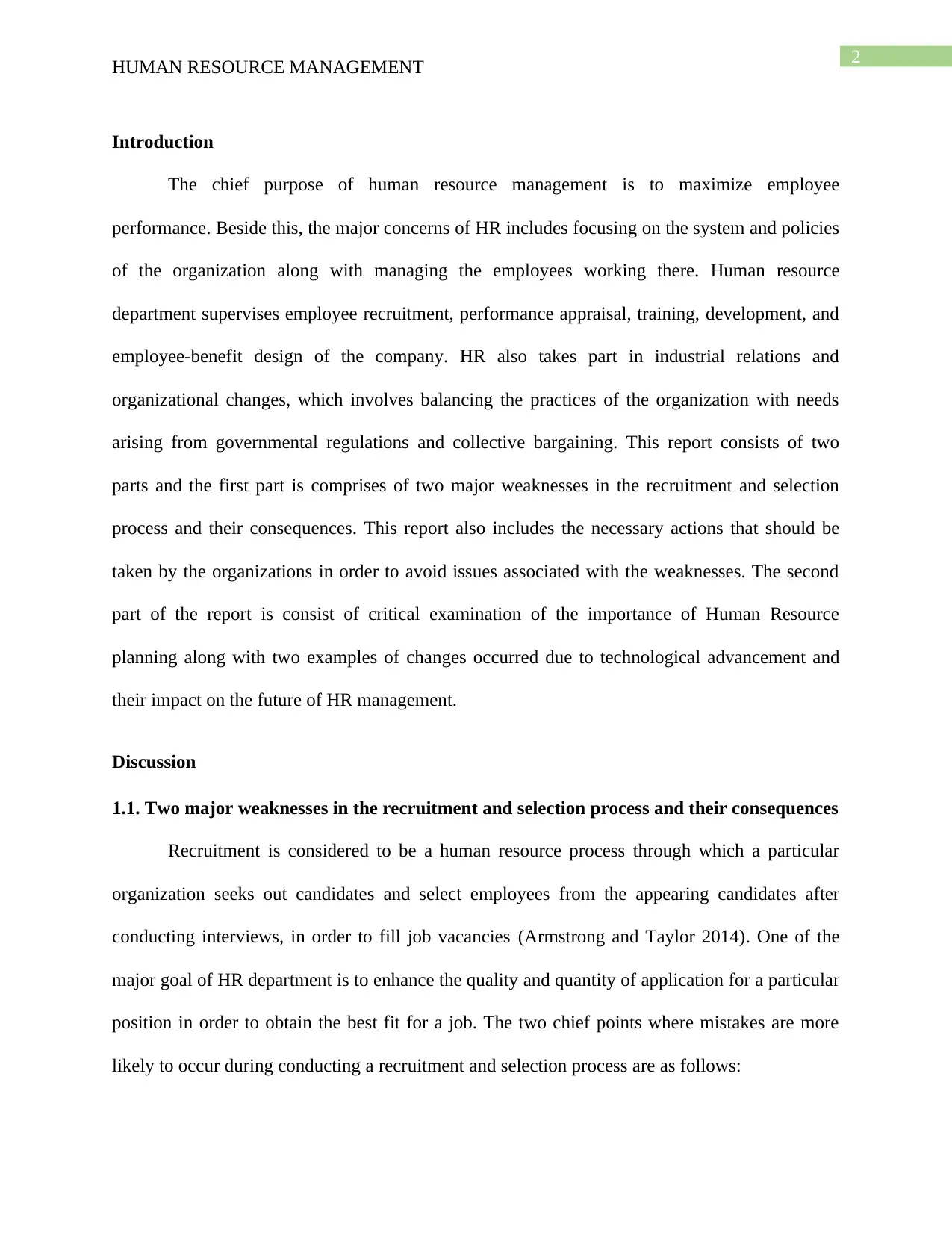
2
HUMAN RESOURCE MANAGEMENT
Introduction
The chief purpose of human resource management is to maximize employee
performance. Beside this, the major concerns of HR includes focusing on the system and policies
of the organization along with managing the employees working there. Human resource
department supervises employee recruitment, performance appraisal, training, development, and
employee-benefit design of the company. HR also takes part in industrial relations and
organizational changes, which involves balancing the practices of the organization with needs
arising from governmental regulations and collective bargaining. This report consists of two
parts and the first part is comprises of two major weaknesses in the recruitment and selection
process and their consequences. This report also includes the necessary actions that should be
taken by the organizations in order to avoid issues associated with the weaknesses. The second
part of the report is consist of critical examination of the importance of Human Resource
planning along with two examples of changes occurred due to technological advancement and
their impact on the future of HR management.
Discussion
1.1. Two major weaknesses in the recruitment and selection process and their consequences
Recruitment is considered to be a human resource process through which a particular
organization seeks out candidates and select employees from the appearing candidates after
conducting interviews, in order to fill job vacancies (Armstrong and Taylor 2014). One of the
major goal of HR department is to enhance the quality and quantity of application for a particular
position in order to obtain the best fit for a job. The two chief points where mistakes are more
likely to occur during conducting a recruitment and selection process are as follows:
HUMAN RESOURCE MANAGEMENT
Introduction
The chief purpose of human resource management is to maximize employee
performance. Beside this, the major concerns of HR includes focusing on the system and policies
of the organization along with managing the employees working there. Human resource
department supervises employee recruitment, performance appraisal, training, development, and
employee-benefit design of the company. HR also takes part in industrial relations and
organizational changes, which involves balancing the practices of the organization with needs
arising from governmental regulations and collective bargaining. This report consists of two
parts and the first part is comprises of two major weaknesses in the recruitment and selection
process and their consequences. This report also includes the necessary actions that should be
taken by the organizations in order to avoid issues associated with the weaknesses. The second
part of the report is consist of critical examination of the importance of Human Resource
planning along with two examples of changes occurred due to technological advancement and
their impact on the future of HR management.
Discussion
1.1. Two major weaknesses in the recruitment and selection process and their consequences
Recruitment is considered to be a human resource process through which a particular
organization seeks out candidates and select employees from the appearing candidates after
conducting interviews, in order to fill job vacancies (Armstrong and Taylor 2014). One of the
major goal of HR department is to enhance the quality and quantity of application for a particular
position in order to obtain the best fit for a job. The two chief points where mistakes are more
likely to occur during conducting a recruitment and selection process are as follows:
⊘ This is a preview!⊘
Do you want full access?
Subscribe today to unlock all pages.

Trusted by 1+ million students worldwide
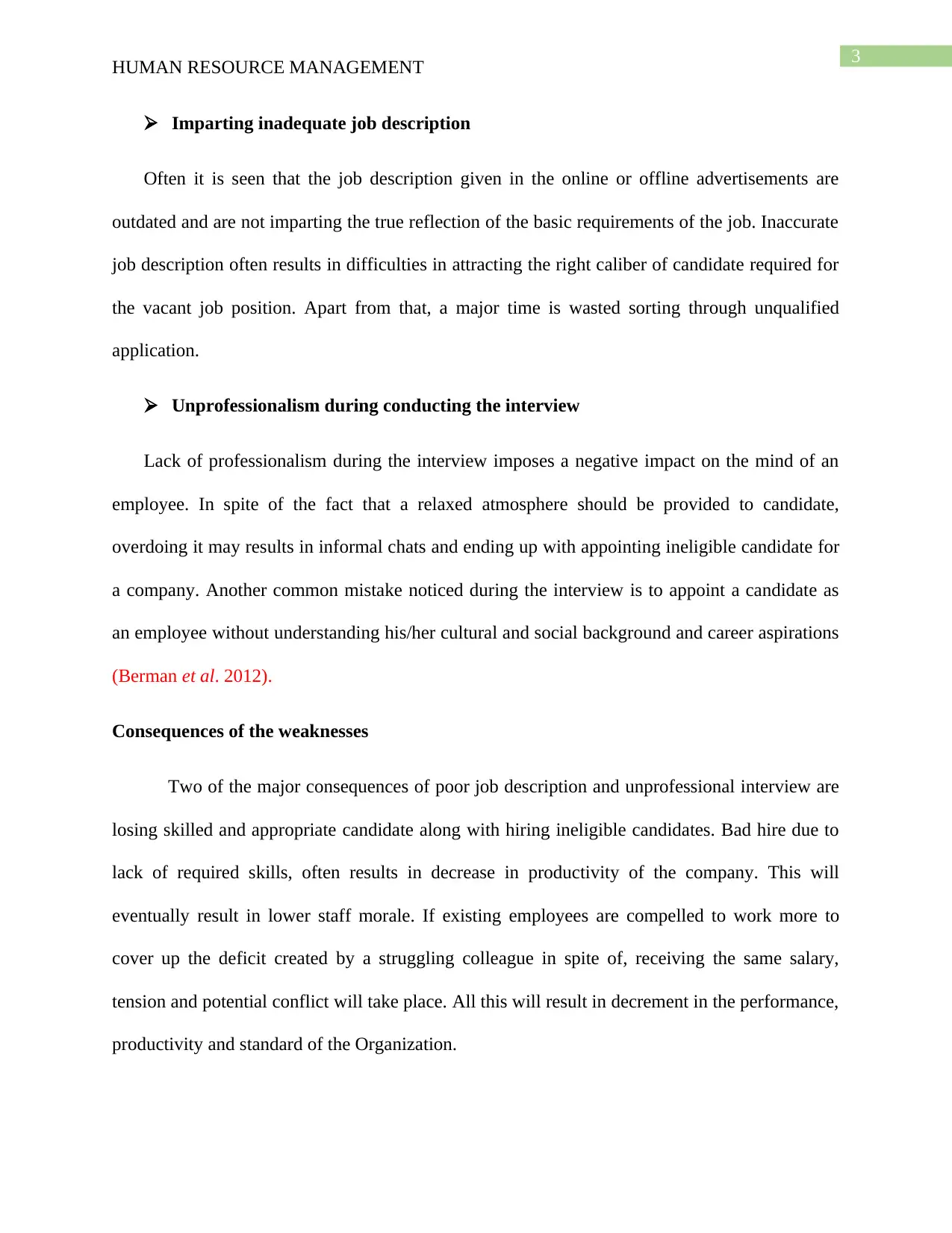
3
HUMAN RESOURCE MANAGEMENT
Imparting inadequate job description
Often it is seen that the job description given in the online or offline advertisements are
outdated and are not imparting the true reflection of the basic requirements of the job. Inaccurate
job description often results in difficulties in attracting the right caliber of candidate required for
the vacant job position. Apart from that, a major time is wasted sorting through unqualified
application.
Unprofessionalism during conducting the interview
Lack of professionalism during the interview imposes a negative impact on the mind of an
employee. In spite of the fact that a relaxed atmosphere should be provided to candidate,
overdoing it may results in informal chats and ending up with appointing ineligible candidate for
a company. Another common mistake noticed during the interview is to appoint a candidate as
an employee without understanding his/her cultural and social background and career aspirations
(Berman et al. 2012).
Consequences of the weaknesses
Two of the major consequences of poor job description and unprofessional interview are
losing skilled and appropriate candidate along with hiring ineligible candidates. Bad hire due to
lack of required skills, often results in decrease in productivity of the company. This will
eventually result in lower staff morale. If existing employees are compelled to work more to
cover up the deficit created by a struggling colleague in spite of, receiving the same salary,
tension and potential conflict will take place. All this will result in decrement in the performance,
productivity and standard of the Organization.
HUMAN RESOURCE MANAGEMENT
Imparting inadequate job description
Often it is seen that the job description given in the online or offline advertisements are
outdated and are not imparting the true reflection of the basic requirements of the job. Inaccurate
job description often results in difficulties in attracting the right caliber of candidate required for
the vacant job position. Apart from that, a major time is wasted sorting through unqualified
application.
Unprofessionalism during conducting the interview
Lack of professionalism during the interview imposes a negative impact on the mind of an
employee. In spite of the fact that a relaxed atmosphere should be provided to candidate,
overdoing it may results in informal chats and ending up with appointing ineligible candidate for
a company. Another common mistake noticed during the interview is to appoint a candidate as
an employee without understanding his/her cultural and social background and career aspirations
(Berman et al. 2012).
Consequences of the weaknesses
Two of the major consequences of poor job description and unprofessional interview are
losing skilled and appropriate candidate along with hiring ineligible candidates. Bad hire due to
lack of required skills, often results in decrease in productivity of the company. This will
eventually result in lower staff morale. If existing employees are compelled to work more to
cover up the deficit created by a struggling colleague in spite of, receiving the same salary,
tension and potential conflict will take place. All this will result in decrement in the performance,
productivity and standard of the Organization.
Paraphrase This Document
Need a fresh take? Get an instant paraphrase of this document with our AI Paraphraser
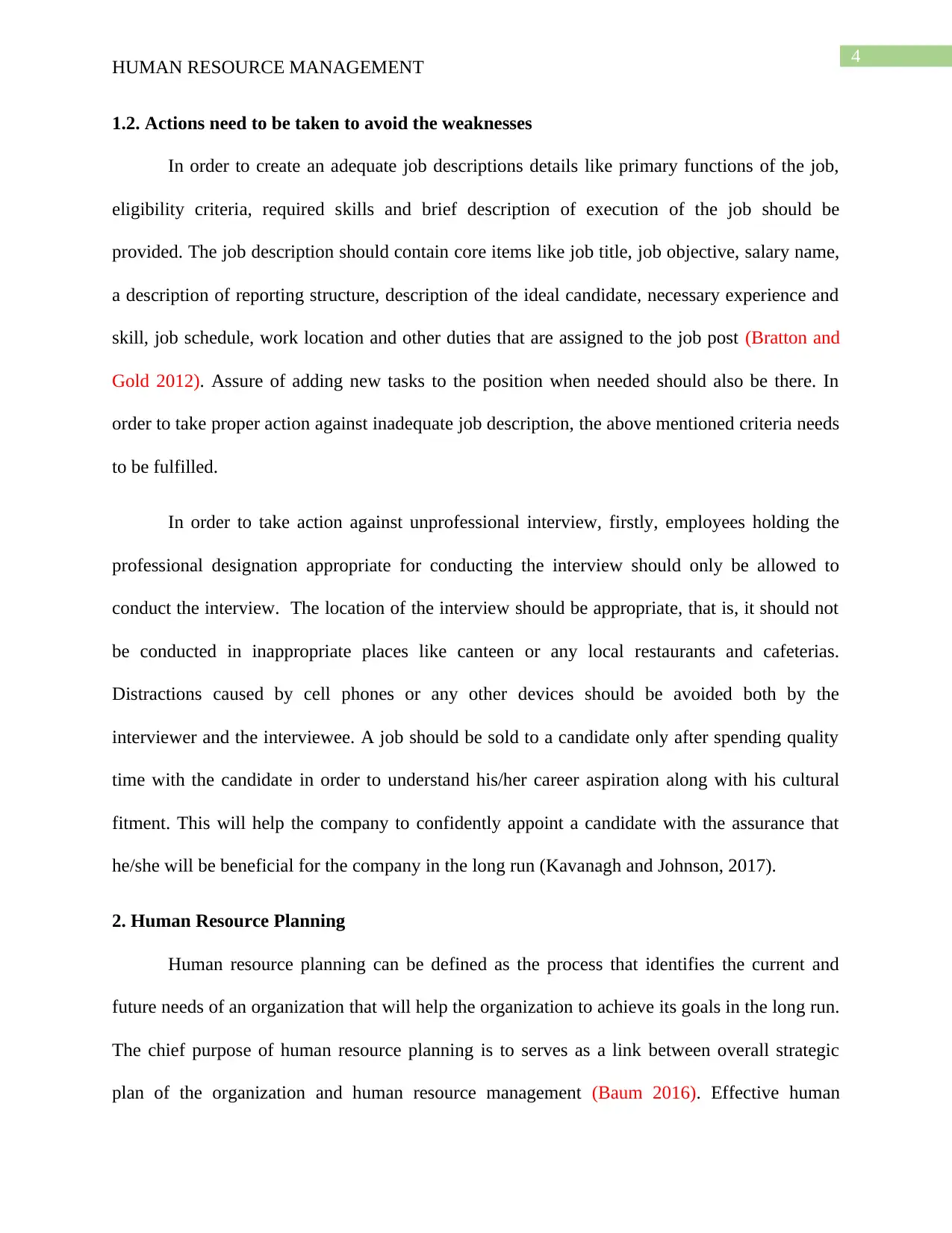
4
HUMAN RESOURCE MANAGEMENT
1.2. Actions need to be taken to avoid the weaknesses
In order to create an adequate job descriptions details like primary functions of the job,
eligibility criteria, required skills and brief description of execution of the job should be
provided. The job description should contain core items like job title, job objective, salary name,
a description of reporting structure, description of the ideal candidate, necessary experience and
skill, job schedule, work location and other duties that are assigned to the job post (Bratton and
Gold 2012). Assure of adding new tasks to the position when needed should also be there. In
order to take proper action against inadequate job description, the above mentioned criteria needs
to be fulfilled.
In order to take action against unprofessional interview, firstly, employees holding the
professional designation appropriate for conducting the interview should only be allowed to
conduct the interview. The location of the interview should be appropriate, that is, it should not
be conducted in inappropriate places like canteen or any local restaurants and cafeterias.
Distractions caused by cell phones or any other devices should be avoided both by the
interviewer and the interviewee. A job should be sold to a candidate only after spending quality
time with the candidate in order to understand his/her career aspiration along with his cultural
fitment. This will help the company to confidently appoint a candidate with the assurance that
he/she will be beneficial for the company in the long run (Kavanagh and Johnson, 2017).
2. Human Resource Planning
Human resource planning can be defined as the process that identifies the current and
future needs of an organization that will help the organization to achieve its goals in the long run.
The chief purpose of human resource planning is to serves as a link between overall strategic
plan of the organization and human resource management (Baum 2016). Effective human
HUMAN RESOURCE MANAGEMENT
1.2. Actions need to be taken to avoid the weaknesses
In order to create an adequate job descriptions details like primary functions of the job,
eligibility criteria, required skills and brief description of execution of the job should be
provided. The job description should contain core items like job title, job objective, salary name,
a description of reporting structure, description of the ideal candidate, necessary experience and
skill, job schedule, work location and other duties that are assigned to the job post (Bratton and
Gold 2012). Assure of adding new tasks to the position when needed should also be there. In
order to take proper action against inadequate job description, the above mentioned criteria needs
to be fulfilled.
In order to take action against unprofessional interview, firstly, employees holding the
professional designation appropriate for conducting the interview should only be allowed to
conduct the interview. The location of the interview should be appropriate, that is, it should not
be conducted in inappropriate places like canteen or any local restaurants and cafeterias.
Distractions caused by cell phones or any other devices should be avoided both by the
interviewer and the interviewee. A job should be sold to a candidate only after spending quality
time with the candidate in order to understand his/her career aspiration along with his cultural
fitment. This will help the company to confidently appoint a candidate with the assurance that
he/she will be beneficial for the company in the long run (Kavanagh and Johnson, 2017).
2. Human Resource Planning
Human resource planning can be defined as the process that identifies the current and
future needs of an organization that will help the organization to achieve its goals in the long run.
The chief purpose of human resource planning is to serves as a link between overall strategic
plan of the organization and human resource management (Baum 2016). Effective human
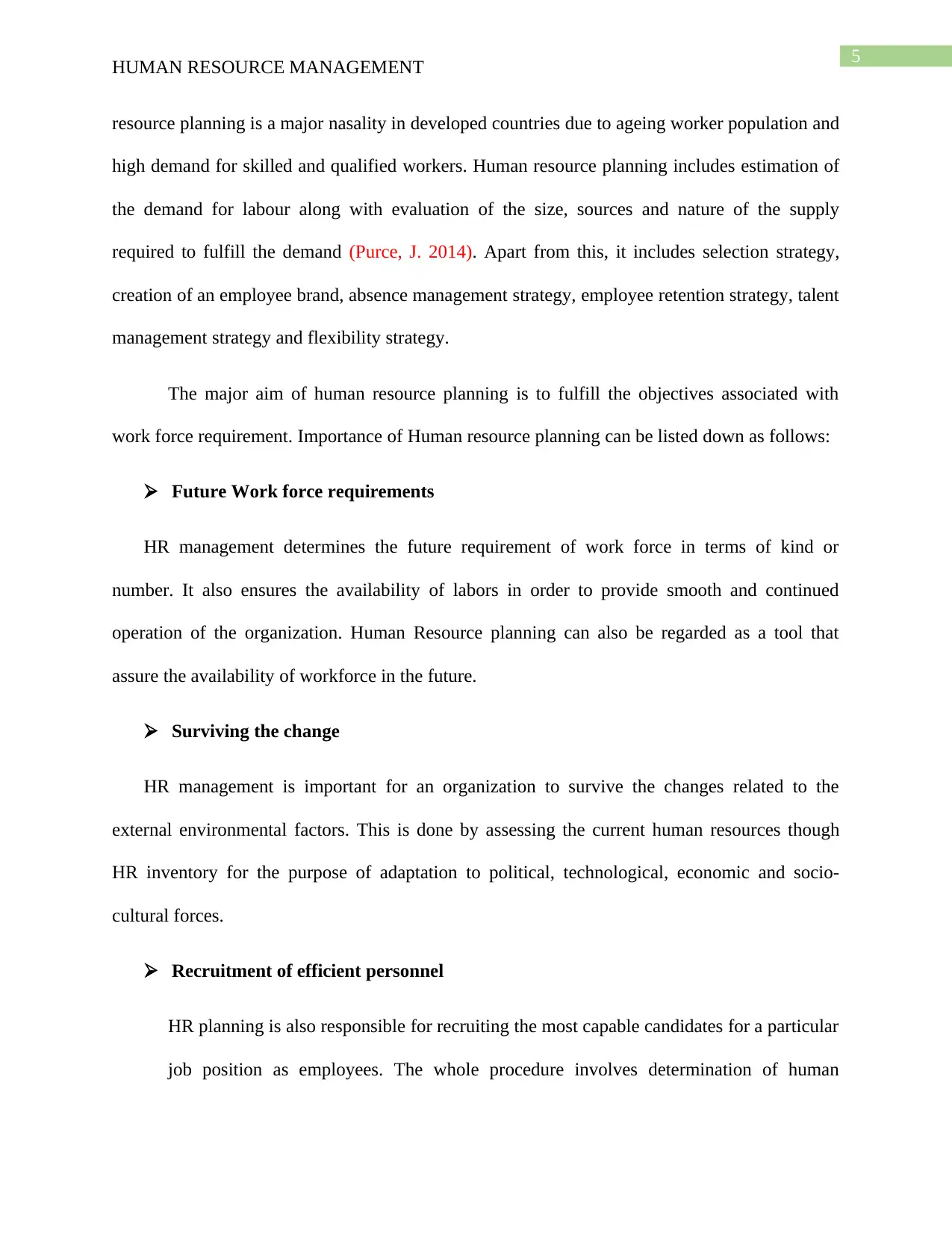
5
HUMAN RESOURCE MANAGEMENT
resource planning is a major nasality in developed countries due to ageing worker population and
high demand for skilled and qualified workers. Human resource planning includes estimation of
the demand for labour along with evaluation of the size, sources and nature of the supply
required to fulfill the demand (Purce, J. 2014). Apart from this, it includes selection strategy,
creation of an employee brand, absence management strategy, employee retention strategy, talent
management strategy and flexibility strategy.
The major aim of human resource planning is to fulfill the objectives associated with
work force requirement. Importance of Human resource planning can be listed down as follows:
Future Work force requirements
HR management determines the future requirement of work force in terms of kind or
number. It also ensures the availability of labors in order to provide smooth and continued
operation of the organization. Human Resource planning can also be regarded as a tool that
assure the availability of workforce in the future.
Surviving the change
HR management is important for an organization to survive the changes related to the
external environmental factors. This is done by assessing the current human resources though
HR inventory for the purpose of adaptation to political, technological, economic and socio-
cultural forces.
Recruitment of efficient personnel
HR planning is also responsible for recruiting the most capable candidates for a particular
job position as employees. The whole procedure involves determination of human
HUMAN RESOURCE MANAGEMENT
resource planning is a major nasality in developed countries due to ageing worker population and
high demand for skilled and qualified workers. Human resource planning includes estimation of
the demand for labour along with evaluation of the size, sources and nature of the supply
required to fulfill the demand (Purce, J. 2014). Apart from this, it includes selection strategy,
creation of an employee brand, absence management strategy, employee retention strategy, talent
management strategy and flexibility strategy.
The major aim of human resource planning is to fulfill the objectives associated with
work force requirement. Importance of Human resource planning can be listed down as follows:
Future Work force requirements
HR management determines the future requirement of work force in terms of kind or
number. It also ensures the availability of labors in order to provide smooth and continued
operation of the organization. Human Resource planning can also be regarded as a tool that
assure the availability of workforce in the future.
Surviving the change
HR management is important for an organization to survive the changes related to the
external environmental factors. This is done by assessing the current human resources though
HR inventory for the purpose of adaptation to political, technological, economic and socio-
cultural forces.
Recruitment of efficient personnel
HR planning is also responsible for recruiting the most capable candidates for a particular
job position as employees. The whole procedure involves determination of human
⊘ This is a preview!⊘
Do you want full access?
Subscribe today to unlock all pages.

Trusted by 1+ million students worldwide
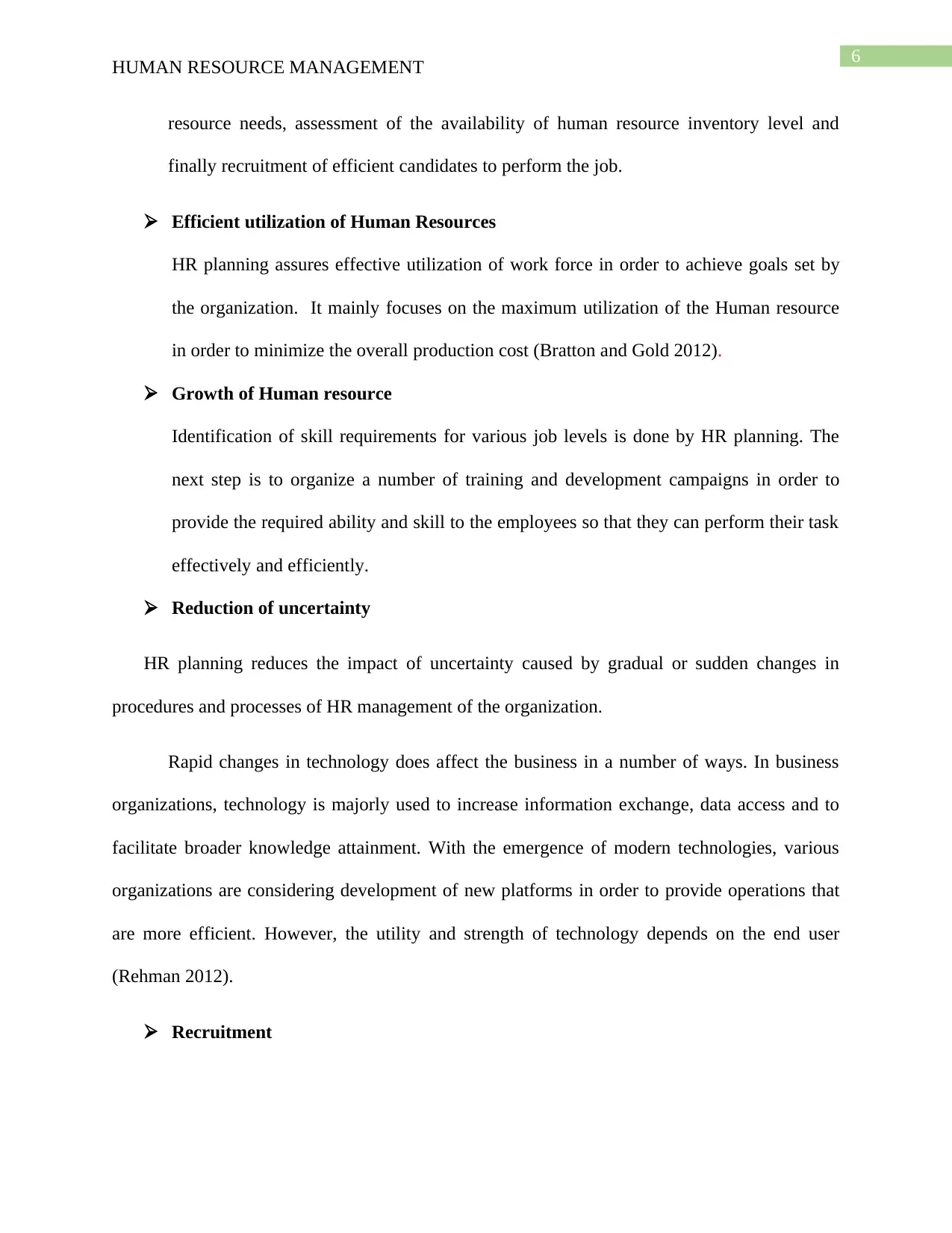
6
HUMAN RESOURCE MANAGEMENT
resource needs, assessment of the availability of human resource inventory level and
finally recruitment of efficient candidates to perform the job.
Efficient utilization of Human Resources
HR planning assures effective utilization of work force in order to achieve goals set by
the organization. It mainly focuses on the maximum utilization of the Human resource
in order to minimize the overall production cost (Bratton and Gold 2012).
Growth of Human resource
Identification of skill requirements for various job levels is done by HR planning. The
next step is to organize a number of training and development campaigns in order to
provide the required ability and skill to the employees so that they can perform their task
effectively and efficiently.
Reduction of uncertainty
HR planning reduces the impact of uncertainty caused by gradual or sudden changes in
procedures and processes of HR management of the organization.
Rapid changes in technology does affect the business in a number of ways. In business
organizations, technology is majorly used to increase information exchange, data access and to
facilitate broader knowledge attainment. With the emergence of modern technologies, various
organizations are considering development of new platforms in order to provide operations that
are more efficient. However, the utility and strength of technology depends on the end user
(Rehman 2012).
Recruitment
HUMAN RESOURCE MANAGEMENT
resource needs, assessment of the availability of human resource inventory level and
finally recruitment of efficient candidates to perform the job.
Efficient utilization of Human Resources
HR planning assures effective utilization of work force in order to achieve goals set by
the organization. It mainly focuses on the maximum utilization of the Human resource
in order to minimize the overall production cost (Bratton and Gold 2012).
Growth of Human resource
Identification of skill requirements for various job levels is done by HR planning. The
next step is to organize a number of training and development campaigns in order to
provide the required ability and skill to the employees so that they can perform their task
effectively and efficiently.
Reduction of uncertainty
HR planning reduces the impact of uncertainty caused by gradual or sudden changes in
procedures and processes of HR management of the organization.
Rapid changes in technology does affect the business in a number of ways. In business
organizations, technology is majorly used to increase information exchange, data access and to
facilitate broader knowledge attainment. With the emergence of modern technologies, various
organizations are considering development of new platforms in order to provide operations that
are more efficient. However, the utility and strength of technology depends on the end user
(Rehman 2012).
Recruitment
Paraphrase This Document
Need a fresh take? Get an instant paraphrase of this document with our AI Paraphraser
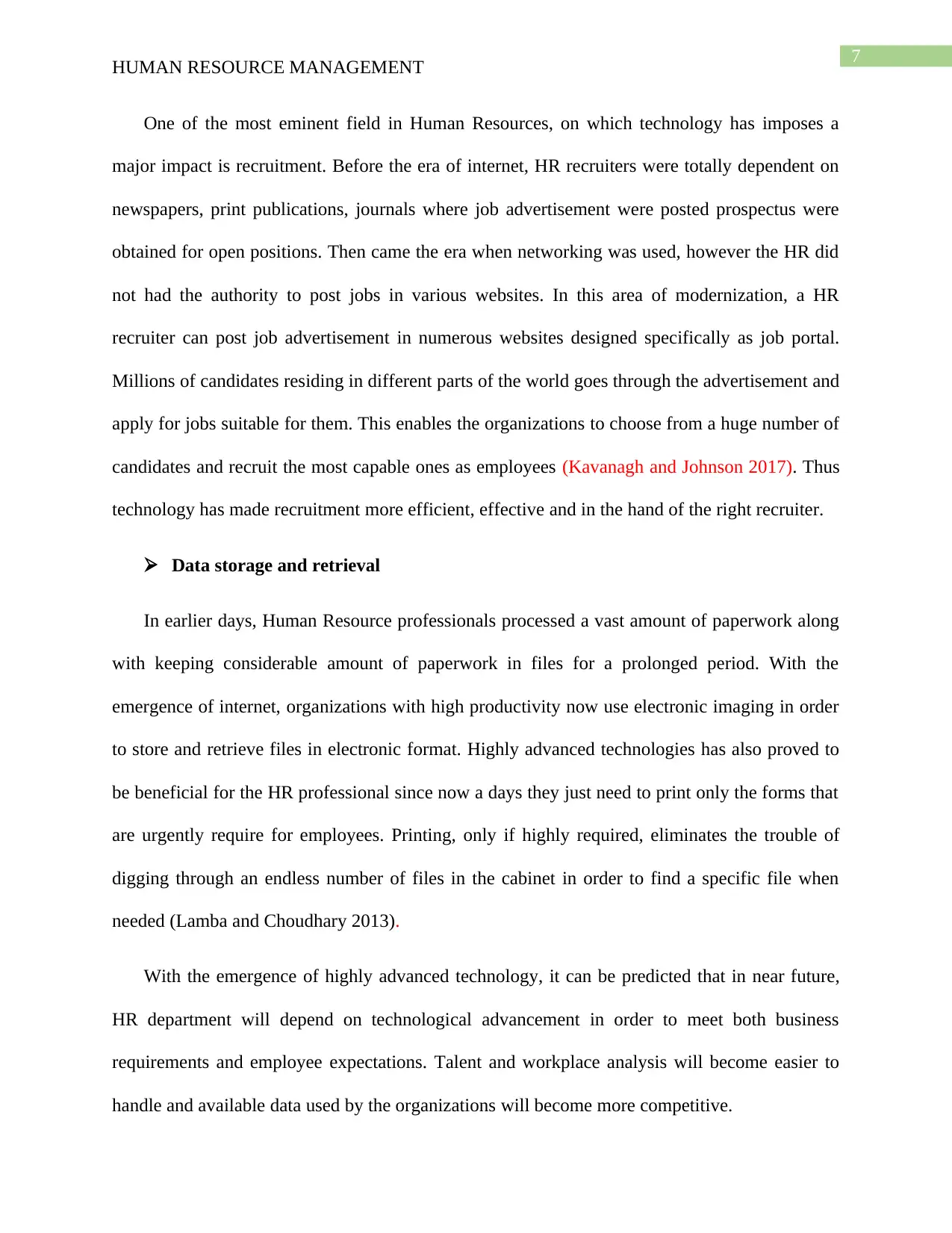
7
HUMAN RESOURCE MANAGEMENT
One of the most eminent field in Human Resources, on which technology has imposes a
major impact is recruitment. Before the era of internet, HR recruiters were totally dependent on
newspapers, print publications, journals where job advertisement were posted prospectus were
obtained for open positions. Then came the era when networking was used, however the HR did
not had the authority to post jobs in various websites. In this area of modernization, a HR
recruiter can post job advertisement in numerous websites designed specifically as job portal.
Millions of candidates residing in different parts of the world goes through the advertisement and
apply for jobs suitable for them. This enables the organizations to choose from a huge number of
candidates and recruit the most capable ones as employees (Kavanagh and Johnson 2017). Thus
technology has made recruitment more efficient, effective and in the hand of the right recruiter.
Data storage and retrieval
In earlier days, Human Resource professionals processed a vast amount of paperwork along
with keeping considerable amount of paperwork in files for a prolonged period. With the
emergence of internet, organizations with high productivity now use electronic imaging in order
to store and retrieve files in electronic format. Highly advanced technologies has also proved to
be beneficial for the HR professional since now a days they just need to print only the forms that
are urgently require for employees. Printing, only if highly required, eliminates the trouble of
digging through an endless number of files in the cabinet in order to find a specific file when
needed (Lamba and Choudhary 2013).
With the emergence of highly advanced technology, it can be predicted that in near future,
HR department will depend on technological advancement in order to meet both business
requirements and employee expectations. Talent and workplace analysis will become easier to
handle and available data used by the organizations will become more competitive.
HUMAN RESOURCE MANAGEMENT
One of the most eminent field in Human Resources, on which technology has imposes a
major impact is recruitment. Before the era of internet, HR recruiters were totally dependent on
newspapers, print publications, journals where job advertisement were posted prospectus were
obtained for open positions. Then came the era when networking was used, however the HR did
not had the authority to post jobs in various websites. In this area of modernization, a HR
recruiter can post job advertisement in numerous websites designed specifically as job portal.
Millions of candidates residing in different parts of the world goes through the advertisement and
apply for jobs suitable for them. This enables the organizations to choose from a huge number of
candidates and recruit the most capable ones as employees (Kavanagh and Johnson 2017). Thus
technology has made recruitment more efficient, effective and in the hand of the right recruiter.
Data storage and retrieval
In earlier days, Human Resource professionals processed a vast amount of paperwork along
with keeping considerable amount of paperwork in files for a prolonged period. With the
emergence of internet, organizations with high productivity now use electronic imaging in order
to store and retrieve files in electronic format. Highly advanced technologies has also proved to
be beneficial for the HR professional since now a days they just need to print only the forms that
are urgently require for employees. Printing, only if highly required, eliminates the trouble of
digging through an endless number of files in the cabinet in order to find a specific file when
needed (Lamba and Choudhary 2013).
With the emergence of highly advanced technology, it can be predicted that in near future,
HR department will depend on technological advancement in order to meet both business
requirements and employee expectations. Talent and workplace analysis will become easier to
handle and available data used by the organizations will become more competitive.
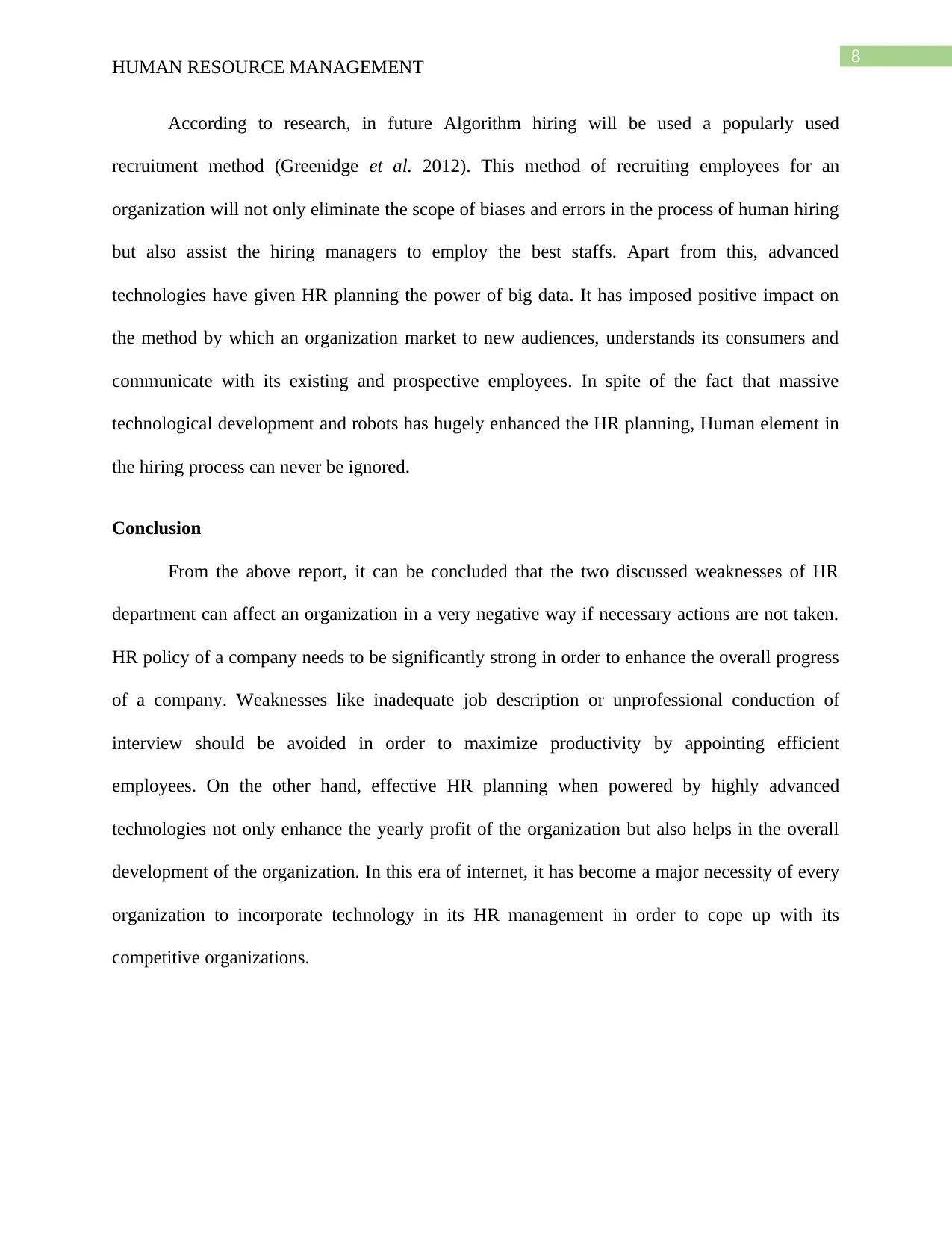
8
HUMAN RESOURCE MANAGEMENT
According to research, in future Algorithm hiring will be used a popularly used
recruitment method (Greenidge et al. 2012). This method of recruiting employees for an
organization will not only eliminate the scope of biases and errors in the process of human hiring
but also assist the hiring managers to employ the best staffs. Apart from this, advanced
technologies have given HR planning the power of big data. It has imposed positive impact on
the method by which an organization market to new audiences, understands its consumers and
communicate with its existing and prospective employees. In spite of the fact that massive
technological development and robots has hugely enhanced the HR planning, Human element in
the hiring process can never be ignored.
Conclusion
From the above report, it can be concluded that the two discussed weaknesses of HR
department can affect an organization in a very negative way if necessary actions are not taken.
HR policy of a company needs to be significantly strong in order to enhance the overall progress
of a company. Weaknesses like inadequate job description or unprofessional conduction of
interview should be avoided in order to maximize productivity by appointing efficient
employees. On the other hand, effective HR planning when powered by highly advanced
technologies not only enhance the yearly profit of the organization but also helps in the overall
development of the organization. In this era of internet, it has become a major necessity of every
organization to incorporate technology in its HR management in order to cope up with its
competitive organizations.
HUMAN RESOURCE MANAGEMENT
According to research, in future Algorithm hiring will be used a popularly used
recruitment method (Greenidge et al. 2012). This method of recruiting employees for an
organization will not only eliminate the scope of biases and errors in the process of human hiring
but also assist the hiring managers to employ the best staffs. Apart from this, advanced
technologies have given HR planning the power of big data. It has imposed positive impact on
the method by which an organization market to new audiences, understands its consumers and
communicate with its existing and prospective employees. In spite of the fact that massive
technological development and robots has hugely enhanced the HR planning, Human element in
the hiring process can never be ignored.
Conclusion
From the above report, it can be concluded that the two discussed weaknesses of HR
department can affect an organization in a very negative way if necessary actions are not taken.
HR policy of a company needs to be significantly strong in order to enhance the overall progress
of a company. Weaknesses like inadequate job description or unprofessional conduction of
interview should be avoided in order to maximize productivity by appointing efficient
employees. On the other hand, effective HR planning when powered by highly advanced
technologies not only enhance the yearly profit of the organization but also helps in the overall
development of the organization. In this era of internet, it has become a major necessity of every
organization to incorporate technology in its HR management in order to cope up with its
competitive organizations.
⊘ This is a preview!⊘
Do you want full access?
Subscribe today to unlock all pages.

Trusted by 1+ million students worldwide
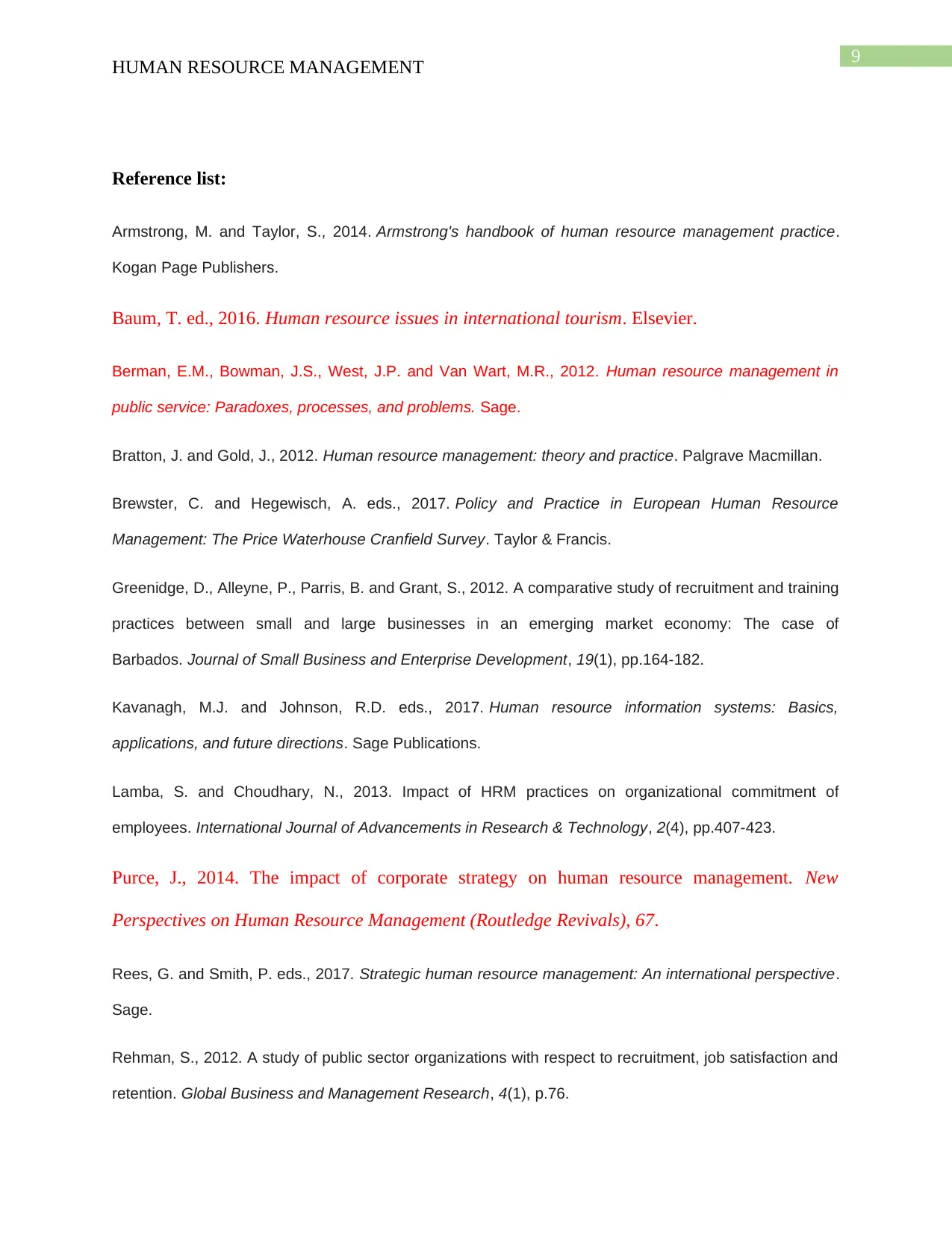
9
HUMAN RESOURCE MANAGEMENT
Reference list:
Armstrong, M. and Taylor, S., 2014. Armstrong's handbook of human resource management practice.
Kogan Page Publishers.
Baum, T. ed., 2016. Human resource issues in international tourism. Elsevier.
Berman, E.M., Bowman, J.S., West, J.P. and Van Wart, M.R., 2012. Human resource management in
public service: Paradoxes, processes, and problems. Sage.
Bratton, J. and Gold, J., 2012. Human resource management: theory and practice. Palgrave Macmillan.
Brewster, C. and Hegewisch, A. eds., 2017. Policy and Practice in European Human Resource
Management: The Price Waterhouse Cranfield Survey. Taylor & Francis.
Greenidge, D., Alleyne, P., Parris, B. and Grant, S., 2012. A comparative study of recruitment and training
practices between small and large businesses in an emerging market economy: The case of
Barbados. Journal of Small Business and Enterprise Development, 19(1), pp.164-182.
Kavanagh, M.J. and Johnson, R.D. eds., 2017. Human resource information systems: Basics,
applications, and future directions. Sage Publications.
Lamba, S. and Choudhary, N., 2013. Impact of HRM practices on organizational commitment of
employees. International Journal of Advancements in Research & Technology, 2(4), pp.407-423.
Purce, J., 2014. The impact of corporate strategy on human resource management. New
Perspectives on Human Resource Management (Routledge Revivals), 67.
Rees, G. and Smith, P. eds., 2017. Strategic human resource management: An international perspective.
Sage.
Rehman, S., 2012. A study of public sector organizations with respect to recruitment, job satisfaction and
retention. Global Business and Management Research, 4(1), p.76.
HUMAN RESOURCE MANAGEMENT
Reference list:
Armstrong, M. and Taylor, S., 2014. Armstrong's handbook of human resource management practice.
Kogan Page Publishers.
Baum, T. ed., 2016. Human resource issues in international tourism. Elsevier.
Berman, E.M., Bowman, J.S., West, J.P. and Van Wart, M.R., 2012. Human resource management in
public service: Paradoxes, processes, and problems. Sage.
Bratton, J. and Gold, J., 2012. Human resource management: theory and practice. Palgrave Macmillan.
Brewster, C. and Hegewisch, A. eds., 2017. Policy and Practice in European Human Resource
Management: The Price Waterhouse Cranfield Survey. Taylor & Francis.
Greenidge, D., Alleyne, P., Parris, B. and Grant, S., 2012. A comparative study of recruitment and training
practices between small and large businesses in an emerging market economy: The case of
Barbados. Journal of Small Business and Enterprise Development, 19(1), pp.164-182.
Kavanagh, M.J. and Johnson, R.D. eds., 2017. Human resource information systems: Basics,
applications, and future directions. Sage Publications.
Lamba, S. and Choudhary, N., 2013. Impact of HRM practices on organizational commitment of
employees. International Journal of Advancements in Research & Technology, 2(4), pp.407-423.
Purce, J., 2014. The impact of corporate strategy on human resource management. New
Perspectives on Human Resource Management (Routledge Revivals), 67.
Rees, G. and Smith, P. eds., 2017. Strategic human resource management: An international perspective.
Sage.
Rehman, S., 2012. A study of public sector organizations with respect to recruitment, job satisfaction and
retention. Global Business and Management Research, 4(1), p.76.
Paraphrase This Document
Need a fresh take? Get an instant paraphrase of this document with our AI Paraphraser
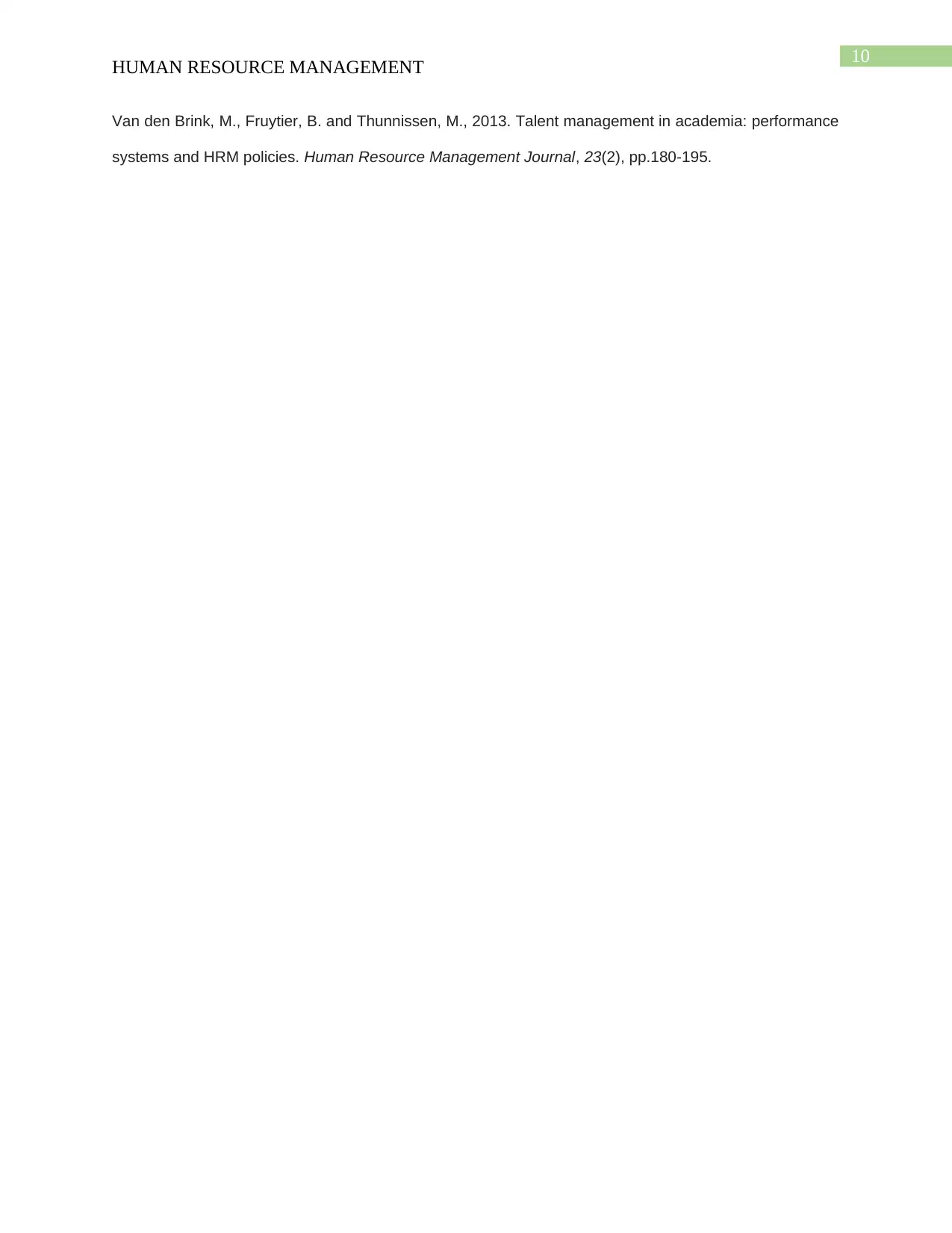
10
HUMAN RESOURCE MANAGEMENT
Van den Brink, M., Fruytier, B. and Thunnissen, M., 2013. Talent management in academia: performance
systems and HRM policies. Human Resource Management Journal, 23(2), pp.180-195.
HUMAN RESOURCE MANAGEMENT
Van den Brink, M., Fruytier, B. and Thunnissen, M., 2013. Talent management in academia: performance
systems and HRM policies. Human Resource Management Journal, 23(2), pp.180-195.
1 out of 11
Related Documents
Your All-in-One AI-Powered Toolkit for Academic Success.
+13062052269
info@desklib.com
Available 24*7 on WhatsApp / Email
![[object Object]](/_next/static/media/star-bottom.7253800d.svg)
Unlock your academic potential
Copyright © 2020–2025 A2Z Services. All Rights Reserved. Developed and managed by ZUCOL.





